托福基础第二次课笔记
老托福语法笔记
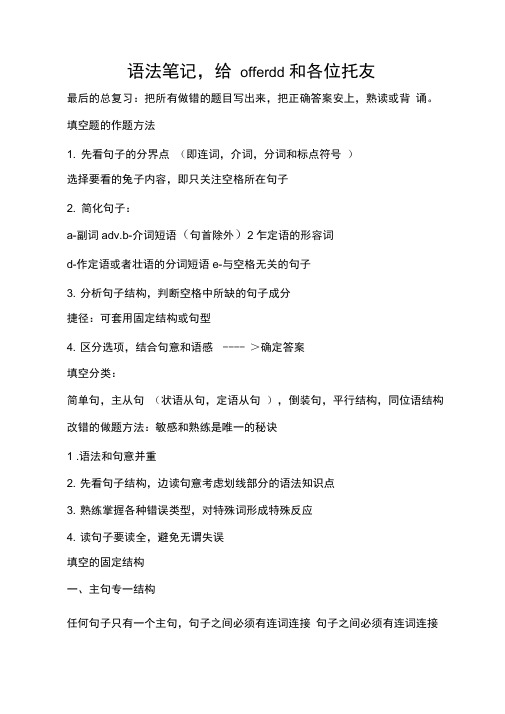
语法笔记,给offerdd 和各位托友最后的总复习:把所有做错的题目写出来,把正确答案安上,熟读或背诵。
填空题的作题方法1. 先看句子的分界点(即连词,介词,分词和标点符号)选择要看的兔子内容,即只关注空格所在句子2. 简化句子:a-副词adv.b-介词短语(句首除外)2乍定语的形容词d-作定语或者壮语的分词短语e-与空格无关的句子3. 分析句子结构,判断空格中所缺的句子成分捷径:可套用固定结构或句型4. 区分选项,结合句意和语感 ---- >确定答案填空分类:简单句,主从句(状语从句,定语从句),倒装句,平行结构,同位语结构改错的做题方法:敏感和熟练是唯一的秘诀1 .语法和句意并重2. 先看句子结构,边读句意考虑划线部分的语法知识点3. 熟练掌握各种错误类型,对特殊词形成特殊反应4. 读句子要读全,避免无谓失误填空的固定结构一、主句专一结构任何句子只有一个主句,句子之间必须有连词连接句子之间必须有连词连接*句子,句子永远错二、谓语专一结构任何句子只有一个谓语,谓语之间必须有连词连接,谓语可以是两个动词的并列形式* 主谓,谓错三、平行结构A,B,or/andCA,B, C三个元素必须对应四、宾语从句结构宾从:S+Vt+(that+SVO)* 看到这些Vt 后,第一反应找that (讲义P21)indicate,state,regard,demonstrate,find,estimate,show,hold,insist,say,tell,believe ,think,learn宾语从句中,that 在下列词后可省:believe,think,suppose,presume,say,see,know,hear,propose,heatunderstand,bet old五、what 结构(A) what=thethingthat=allthat,thing 由句意决定(B) what 必须在前后句中都作成分(C) noun.+what 永远错(D) what 引导的句子等于一个名词,可以用作介词或者动词的宾语what+V=thethingthat+Vprep.+what+V*prep.+what+ 完整句子永远错,改为whichVt+what+V(E) what 的出题方法(1)prep __________ V(2)Vt __________ V(F) *whatisnow 永远对,做插入语成分where+V 永远错,因为where 是adv.(G) whatlittle=alittlewhat六、介词+which 结构which 只能用于定语从句,在从句中必须作主/ 宾语(A) SVO+which+不完整句(缺主语)(B) SVO+prep.+which完整句* 句子_______ 句子,优先选择prep+which(C) 介词+which+todo条件是主语必须一致七、inthat 结构in that二because连词,出现就是正确答案不能位于句首:句子inthat 结构* 如果发现句子______ 句子,优先选择prep+which 和inthat 结构八、同位语结构主同,宾同,n同位语说明主/ 宾某一方面的内容(A) 主语同位语的三种位置1. -------------------------------- 主同,主谓宾noun,SVO逗号前的名词只能是主同2.S主同,V03.主同主谓宾(B) 宾语同位语的两个位置主谓宾,宾同主谓宾宾同*同位语从句是名词性从句:..... +noun .+that+SVOthat 是关系副词SVO来说明noun.*adv. 不能修饰任何名词但是adv.+同位语是正确的:...,(whichis)approximatelythedistanee.九、形容词的并列结构----- >可参考改错类型十(A) adjadjadj+noun.n 个adj 不并列,有确定的先后顺序(B) 当多个形容词用逗号连接时,这几个形容词完全对等,无先后顺序(逗号相当于and)* 选项中有复合形容词即为答案十、比较结构(A) 对称性:比较对象应该对称* 选that/those/theone ---- 泛指不选it/them -------------- 特指(B) 省略性:相同的谓语结构可以省,be动词通常省(C) 倒装性:(more)than后可以倒装也可以不倒装十一、定语从句的省略结构(A) 定语从句中,主+系可以同时省略即that+be,which+be,who+be可省(B) 定从的特殊省略eg:IdorememberthefirsttimeIhaveheardthesweetestvoiceintheworld.1 、thetime 后面通常+句子,因为(when,that)都省略2、thereason(why,that)+句子3、theway(inwhich)+句子(C定从中,如果that/which在定从中作宾语(讲义P26)that/which 可省略(作主语不可省)SVO+(that,which)+S+Vt...noun.+(which,that)noun.+Vt*题目中两个名次连不上的情况即省略发生了(讲义No.27)。
TOEFL语法笔记

TOEFL语法笔记王海波代词95%为错,情态动词永远不错,first 划线永远对,虚拟语气不考。
填空的基本做法:1 先找句子的分段点(即连词,分词,介词和标点符号)将句子分成记几段,选择要看的那部分句子,即只关注与空格相关的那部分句子。
句法:{①简单句: S+V②并列句:分句+并列句子+;句子+。
并列句划为简单句:句子,and/all/but+句子。
③复合句:主句+从句划为简单句2 简化句子简化原则:①adv/数/冠可以划掉②介词短语可以划掉③修饰名词的adj/n可以划掉④做状语的分词短语可以划掉⑤与空格无关的句子可以很划掉 p65-5/83 分析句子结构,判断空格中所缺的句子成分。
捷径:可直接套用句型和结构 p53-14 ,倒装句答案的首字母为系动词或助动词p92-14 * ——+n为There be 句型p210-74 区分四选项,结合句意和语感确定答案。
句子→简单句→主干→判断→选答案主语,——,谓宾。
100%考↓插入语定语从句或省略的定语从句定语从句中主和系可以同时省略which+be/that+be/who+be 可以省略①定语从句②n③adj短语/分词短语/介词改错做题要点:1 语法与句意并重,一定要通读全句(做题思想)。
2 一边读句意,一边思考划线部分的语法知识点是否正确。
3 熟悉掌握各种错误类型。
4 做题 ABCD要看全,选择一个最明显的错误,最好有明确的理由。
填空的固定句型和结构一主句专一结构 1-2※句子,句子。
为错任何句子只有一个主句,句子之间必须有连词。
※任何从句都是正常语序。
二谓语专一结构 3-4任何一个句子只有一个谓语,谓语动词之间一定要有连词连接。
※主谓……谓……错主谓……,谓……。
错三平行结构 5-6X and YX ,Y and Z 各元素必须一致 to do ,do and do 。
be done ,done and done。
※——,——,and——。
四 what 结构 7-8缩合连接代词(1)what =the thing that =all that thing 由句意定7 中what =the corp that 8 中what =the place that(2)what 在前后句中必须同时做成分 what =the thing that(3)n+what 错 n+the thing that √※prep+what+SVO 错 what →which√(4)what 引导的句子等于一个名词,可以做主语,宾语,表语。
新东方TOEFL复习笔记(第一部分:听力)2
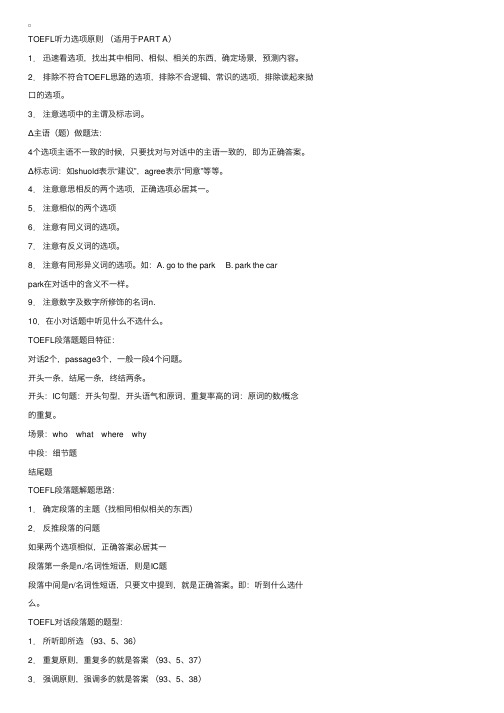
TOEFL听⼒选项原则(适⽤于PART A)1.迅速看选项,找出其中相同、相似、相关的东西,确定场景,预测内容。
2.排除不符合TOEFL思路的选项,排除不合逻辑、常识的选项,排除读起来拗⼝的选项。
3.注意选项中的主谓及标志词。
Δ主语(题)做题法:4个选项主语不⼀致的时候,只要找对与对话中的主语⼀致的,即为正确答案。
Δ标志词:如shuold表⽰“建议”,agree表⽰“同意”等等。
4.注意意思相反的两个选项,正确选项必居其⼀。
5.注意相似的两个选项6.注意有同义词的选项。
7.注意有反义词的选项。
8.注意有同形异义词的选项。
如:A. go to the park B. park the car park在对话中的含义不⼀样。
9.注意数字及数字所修饰的名词n.10.在⼩对话题中听见什么不选什么。
TOEFL段落题题⽬特征:对话2个,passage3个,⼀般⼀段4个问题。
开头⼀条,结尾⼀条,终结两条。
开头:IC句题:开头句型,开头语⽓和原词,重复率⾼的词:原词的数/概念的重复。
场景:who what where why中段:细节题结尾题TOEFL段落题解题思路:1.确定段落的主题(找相同相似相关的东西)2.反推段落的问题如果两个选项相似,正确答案必居其⼀段落第⼀条是n./名词性短语,则是IC题段落中间是n/名词性短语,只要⽂中提到,就是正确答案。
即:听到什么选什么。
TOEFL对话段落题的题型:1.所听即所选(93、5、36)2.重复原则,重复多的就是答案(93、5、37)3.强调原则,强调多的就是答案(93、5、38)4.建议原则,有建议的就是考点。
5.对话题结构特点:开头:打招呼后,信息作为开头。
结尾:最后⼀句。
TOEFL错题原因:慢热(听时不看) Part A⾛神(延长时间)连错(学会放弃)读题(先紧后松)⽼题重要题型:中间带but转折题:1.语⽓转折: 90.1.33/96.12.A142.表单词多种含义 89.8.24/96.10.A2对⼀般疑问句的回答:1.听清第⼆句开头的短结构 89、8、322.间接回答⼀定表⽰反对 96、10、A123.听不懂没关系(第⼆句长⽽绕),选⼀个否定答案就可以 96、8、30 4.第⼀句语调特征:最后为升调5.第⼆句习语。
托福笔记
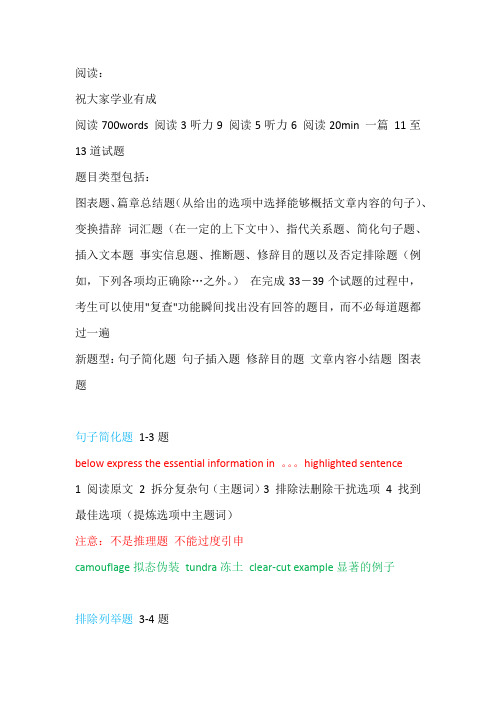
阅读:祝大家学业有成阅读700words 阅读3听力9 阅读5听力6 阅读20min 一篇11至13道试题题目类型包括:图表题、篇章总结题(从给出的选项中选择能够概括文章内容的句子)、变换措辞词汇题(在一定的上下文中)、指代关系题、简化句子题、插入文本题事实信息题、推断题、修辞目的题以及否定排除题(例如,下列各项均正确除…之外。
)在完成33-39个试题的过程中,考生可以使用"复查"功能瞬间找出没有回答的题目,而不必每道题都过一遍新题型:句子简化题句子插入题修辞目的题文章内容小结题图表题句子简化题1-3题below express the essential information in 。
highlighted sentence1 阅读原文2 拆分复杂句(主题词)3 排除法删除干扰选项4 找到最佳选项(提炼选项中主题词)注意:不是推理题不能过度引申camouflage拟态伪装tundra冻土clear-cut example显著的例子排除列举题3-4题题干中not except less least1 单词列举题一句话中很多逗号分开单词看题看确定什么题看选项找关键字回原文找2 短语列举题3 句子列举题thaw融化textile industry 棉纺业premium 赠品phase out取消插入句子题1-2题look at four squares that indicate 题目中有个涂黑的方框1 看题干,判断题型2 找关键词路标词THESE THOSE EARLYthus句子逻辑关系3 回原文词汇题4-5题占考试三分之一1 背单词2 上下文找答案3 行结构平行同意来猜(and前后同意)4 反义关系(有反义标记词出现but,rather than)5 短语和词组看尾巴或者介词forward on与from to意思不同6 合成词切割成最小单位前缀字根后缀rudimentary rudi粗糙的ment名词后缀ary形容词后缀7 代入法带入文章中8 一词多义Nevertheless但是meticulously细致地primitive朴素parasitic寄生well lit光线足的指代题题目标志。
《托福备考笔记》word版
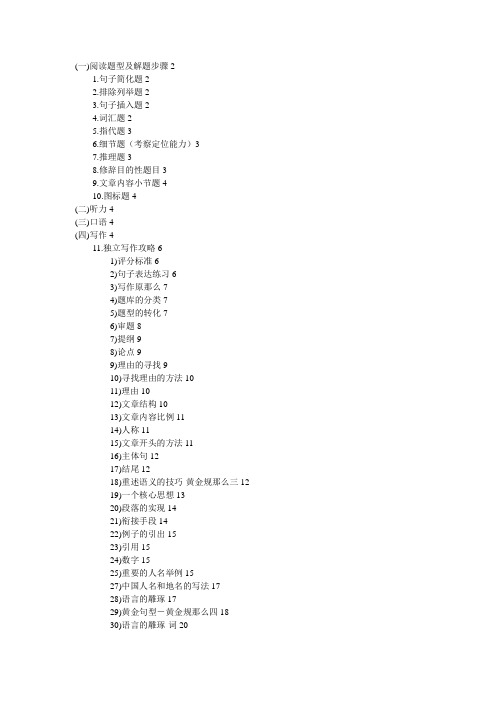
(一)阅读题型及解题步骤21.句子简化题22.排除列举题23.句子插入题24.词汇题25.指代题36.细节题(考察定位能力)37.推理题38.修辞目的性题目39.文章内容小节题410.图标题4(二)听力4(三)口语4(四)写作411.独立写作攻略61)评分标准62)句子表达练习63)写作原那么74)题库的分类75)题型的转化76)审题87)提纲98)论点99)理由的寻找910)寻找理由的方法1011)理由1012)文章结构1013)文章内容比例1114)人称1115)文章开头的方法1116)主体句1217)结尾1218)重述语义的技巧-黄金规那么三1219)一个核心思想1320)段落的实现1421)衔接手段1422)例子的引出1523)引用1524)数字1525)重要的人名举例1527)中国人名和地名的写法1728)语言的雕琢1729)黄金句型-黄金规那么四1830)语言的雕琢-词2031)词汇选择的标准2112.综合写作攻略211)评分标准(5分)2132)出题方式2133)学习要点(P75)2134)如何却定要点-黄金规那么四2235)如何对付陌生名词2236)寻找并纪录要点的训练方法2237)文章框架2238)如何结构段落2239)表示相反关系的词和短语2340)精彩句型2341)对材料的指称2342)对时态的运用24(一)阅读题型及解题步骤1.句子简化题1)阅读原文2)拆分复杂句:把握句子要点,抓住主题词3)用排除法删除干扰选项4)找到最佳选项提炼选项中的关键词2.排除列举题Not except less least三种考法1)单词列举题2)短语列举题(提炼选项中的一两个关键词)3)句子列举题做题步骤:1)看题干,判断是什么题2)看选项3)看题干找关键字4)回到原文中找3.句子插入题1)看题干,判断题型2)看题目中给的话,找关键字和要点a)关键字要点b)关联词和路标词c)看自己逻辑关系3)回到原文,阅读可插入方块的前后信息,寻找与插入句相关的意思4)选择与插入句最相关的方块4.词汇题1)背单词托福要求8000多单词2)在文章的上下文中找答案3)在上下文中利用平行结构,平行同意关系来猜4)反义关系5)短语和词组看尾巴或者介词6)合成词切割成最小单位(即切割成前缀,后缀)7)代入法,将四个选项依次代入原文中看哪一个最符合上下文的意思8)一词多义5.指代题1)指代题反映的是英文的简单原那么,因此指代都是往前找答案-后指代前在一句话中或相邻的两句话中,后半句的代词主语经常指代前半句话的名词主语2)如果一句话中有两个并列的及物动词,第二个动词后面的代词宾语经常指代前一个动词后面的名词宾语3)所有格代词经常指代他前面位置上最接近的名词但是要注意两个条件a)有短语时b)指代的经常是前面的核心名词4)平行结构-前后呼应,前后平行5)多重指代-文章中不止一个代词6)注意代词指代中的单复数问题7)代词指代词一定要验证一遍8)在整个题目做完之后,把代词和代词之前的话通读一遍来验证6.细节题(考察定位能力)1)看题目找关键字2)带着关键字回原文中找地方3)看选项找到原文的改写7.推理题题干中常见问法1)infer2)imply3)most likely4)probably推理题的做题步骤1)先看题干,看到刚刚那些词汇,判断出该题是一道推理题2)带着题干中的关键字回到原文中找地方3)读完原文到选项中寻找答案与细节题不一一样,有一个推理的过程时间概念推断8.修辞目的性题目如果在考试中见到三篇文章,经常会有两到三道这样的题目出现角色转换不要把自己看成读者,而是以作者的角度思考文章的结构及内容安排第二段开头:on the other hand第二段与第一段讲的是不同的内容,是一种转折关系一句话的目的9.文章内容小节题1)仔细阅读内容概要表中列出的主题2)把主题成几个意群,找到关键字或主题词10.图标题(二)听力(三)口语新托福的报名()(四)写作●综合写作:150-225 words不能有自己的任何见解●Time:1)Integrated writing: 20 minute sReading:3mins\230-300wordsListening: 2mins\230-300words2)独立写作:300字以上,高分400字以上●写作训练方法:写●练习写作的步骤:需要写20篇左右的文章1)1-5篇不限时写作,字数达到300,结构完整,不计好坏2)6-10保证1小时内完成,结构完整,字数达到300以上,写完进行检查3)11-20要半个小时内完成,字数超过400,结构完整,写完进行检查和润饰。
新东方TOEFL复习笔记(第二部分:语法笔记)1(5)

k)定语从句的省略结构:(讲义 26 27)1.如果that / which在定从中作obj,可以省略.sub+vt+n+(which / that)+sub+vt→s+vt+n+s+v s+vt+n1+n2+vt*当做题时,若发现两个名词在⼀起,但是似乎连不上,则⼀定省略that / which,则动词为vt,做谓语。
2.定从的特殊省略(新题 P92 13)the way (in which) + 句⼦the reason (why that)+句⼦ 均为完整句the time (that / when)+句⼦I do remember the first time (that省) I ever heard the sweatest voicein the world.By the time省that+句⼦,句⼦。
3.定从的主系省略(主+系可同时省)即:which be , who be , that be可同时省(讲义P7 17)*在新题中难题常与which be的省略有关(新题 P196 15)l)状语从句的省略结构:(讲义 P8 28 29)Although (it is)native to Europe, svo.Although (she was) affluted by…svo.Even though (it is) costly,svo.省略条件:1)特定的状语从句引导词:although though even though when while if as2)从句为主系表结构3)从句主语与主句主语⼀致。
Alought (主+系)+表,主谓宾。
省略⽅式:a)可以同时省略主+系→连词+表语(a. 分词 svo)b)主系必须同时省c) Alough / Thouth / While / If / As / When +(系表)+a./分词,svo√ ⼀定是答案m)doing结构:(讲义 30 31)doing现在分词→ a./ad.作定于/状语动名词→ n. 作主语/宾语eg:1)Stranving troop have to surrender.现在分词修饰n.,翻译为“…的”2)Transforming faw materials into useful products is called maufacturing. (Transforming:动名词)具有动词特征的n做主语或者宾语,但同时⼜可接宾语,动名词与n为动宾关系,中⼼词为v-ing,翻译为“…的⾏为”。
2019年5月TOEFL语法笔记共9页
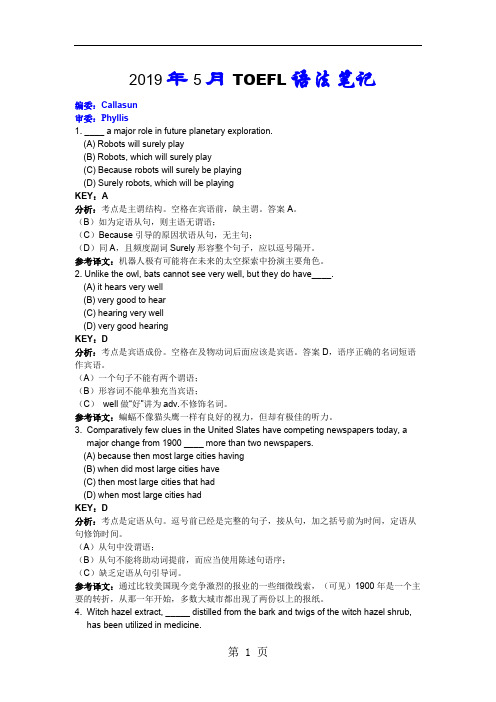
2019年5月TOEFL语法笔记编委:Callasun审委:P hyllis1. ____ a major role in future planetary exploration.(A) Robots will surely play(B) Robots, which will surely play(C) Because robots will surely be playing(D) Surely robots, which will be playingKEY:A分析:考点是主谓结构。
空格在宾语前,缺主谓。
答案A。
(B)如为定语从句,则主语无谓语;(C)Because引导的原因状语从句,无主句;(D)同A,且频度副词Surely形容整个句子,应以逗号隔开。
参考译文:机器人极有可能将在未来的太空探索中扮演主要角色。
2. Unlike the owl, bats cannot see very well, but they do have____.(A) it hears very well(B) very good to hear(C) hearing very well(D) very good hearingKEY:D分析:考点是宾语成份。
空格在及物动词后面应该是宾语。
答案D,语序正确的名词短语作宾语。
(A)一个句子不能有两个谓语;(B)形容词不能单独充当宾语;(C)well做“好”讲为adv.不修饰名词。
参考译文:蝙蝠不像猫头鹰一样有良好的视力,但却有极佳的听力。
3. Comparatively few clues in the United Slates have competing newspapers today, amajor change from 1900 ____ more than two newspapers.(A) because then most large cities having(B) when did most large cities have(C) then most large cities that had(D) when most large cities hadKEY:D分析:考点是定语从句。
托福听力TPO2学习笔记之lecture1-智课教育旗下智课教育
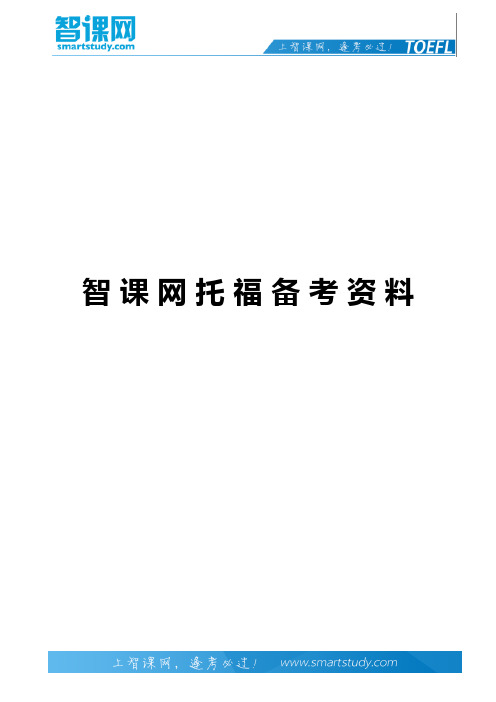
智 课 网 托 福 备 考 资 料托福听力TPO2学习笔记之lecture1-智课教育旗下智课教育以下是小编在学习托福听力TPO2中的lecture1时做的学习笔记,针对难词注解、长难句分析以及考题对应考点这三大方面展开,仅供参考。
下面就让小编来为大家介绍一下这篇托福听力TPO2学习笔记的内容吧,这是小编的一些见解,以便帮助大家更加充分的理解TPO真题,希望能够给正在准备托福听力的考友们带来帮助。
托福听力TPO2学习笔记之lecture1一、难词注解1.mental processes心理过程ryngeal adj. 喉的;rynx 喉头4.concept n. 观念,概念5.ideomotor action [心理] 动念动作6.equivalent 等价的二、长难句分析He argued that for very young children, thinking is really talking out loud to oneself because they talk out loud even if they’re not trying to communicate with someone in particular. 他认为对很小的小孩而言,思考就是大声跟自己讲话,因为小孩即便是自言自语时声音也不小。
难句类型:He argued that+宾语从句(包含由because引导的原因状语从句)难句结构拆分:首先是He argued that+宾语从句,宾语从句中又包含由because 引导的原因状语从句,而其主句中有插入语for very young children,从句中又包含一个 even if 引导的让步状语从句。
三、考题对应考点考题对应文章考点分析:6. 开头原则,背景引入式What Watson did was to observe muscular habits because he viewed them as a manifestation of thinking. 开头交代文章要讨论的问题,所以答案选C7. 语音语调强调,中间有停顿要注意Watson thought laryngeal habits . . . you know, from larynx, in other words, related to the voice box . . . he thought those habits were an expression of thinking. 换句话说,解释说明,所以答案选B.8. Uh, he did indeed, um, and to jump ahead, what one finds in deaf individuals who use sign language when they’re given problems of various kinds, they have muscular changes in their hands when they are trying to solve a problem . . .托福听力十三原则中的强调原则,所以答案选C.9. 在原文中Well, if you close your eyes and think of the library, and if you’re sitting directly facing me, then according to this notion, your eyeballs will move slightly to the left, to your left, ‘cause the library’s in that general direction,认得眼睛会下意识的往自己想的方向转,所以答案选C.10. 强调原则It’s called ideomotor action. Ideomotor action is an activity that occurs without our noticing it, without our being aware of it. a magic trick就是举例子说明人们有时候注意不到自己的行为。
Rtrhfw新托福考试中记笔记方法(精华贴整理)技巧归纳

NO.*1N0.* 秋风清,秋月明,落叶聚还散,寒鸦栖复惊。
怎样记笔记(1)自己的前言:该方法比较适用口语后四题和作文的综合部分不太适用于听力!口语后题和作文中最重要的一点就是specific,如何做到specific 呢,关键就是要有好的细节,而细节往往就是笔记中最难把握的我之所以说该方法不怎么适用于听力,是因为听力相对来说考察的是对段子整体的把握。
当然,里面的符号可以让大家借鉴一下符号是共通的。
人类瞬时记忆的有限性,可以用速记方式加以弥补。
新托福考试增加的口语部分就允许考生在听、读的同时作些笔记。
这对考生在紧张的状态下产生的“听时明白听后忘;读时明白读完忘”的现象确实是一个有益的帮助。
快而准的笔记能帮助考生准确地回忆刚刚读到、听到的内容,进而使考生能用恰当的语言准确地回答问题以取得满意的成绩。
因而,培养一种高效的速记能力在新托福考试中不仅显得至关重要,而且势在必行。
考试中运用怎样的速记方法因人而异,你甚至可以自创一套独特的、只有自己可以辨认的速记符号,但关键的问题是你的速记要有助于你迅速而准确地回想起一次性听到的、读到的东西。
所以,“快”而“准”就成了迅速记笔记所应遵循的准则。
下面就为大家列举一些常用的笔记符号:SymbolMeaning →go on, continue, last, lead to, cause, result in, make, produce, stretch, develop, to the right ←come from, result from, go back, withdraw, shorten, to the left↑go up, increase, rise, raise, get up, arise, evaporate, fly ↓go down, decrease, lower, reduce, decline, sediment, save up, deposit ∵because ∴so, therefore, thus +plus, and also, in addition -minus ×times =equal, equal to, is ≠not equal, not equal to, is not ~about, approximately, probably, more or less >larger than, bigger than, greater than, more than <smaller than, less than %percent ∕per。
TOEFL普林斯顿样题2语法笔记解读
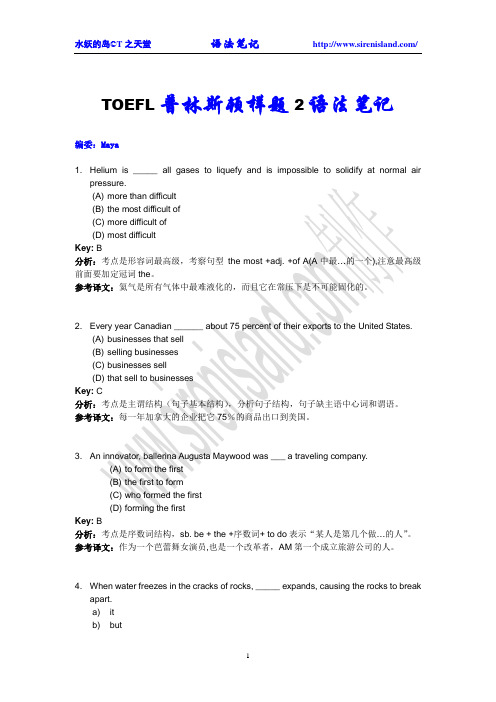
TOEFL普林斯顿样题2语法笔记编委:Maya1. Helium is _____ all gases to liquefy and is impossible to solidify at normal airpressure.(A) more than difficult(B) the most difficult of(C) more difficult of(D) most difficultKey: B分析:考点是形容词最高级,考察句型the most +adj. +of A(A中最…的一个),注意最高级前面要加定冠词the。
参考译文:氦气是所有气体中最难液化的,而且它在常压下是不可能固化的。
2. Every year Canadian ______ about 75 percent of their exports to the United States.(A) businesses that sell(B) selling businesses(C) businesses sell(D) that sell to businessesKey: C分析:考点是主谓结构(句子基本结构),分析句子结构,句子缺主语中心词和谓语。
参考译文:每一年加拿大的企业把它75%的商品出口到美国。
3. An innovator, ballerina Augusta Maywood was ___ a traveling company.(A) to form the first(B) the first to form(C) who formed the first(D) forming the firstKey: B分析:考点是序数词结构,sb. be + the +序数词+ to do表示“某人是第几个做…的人”。
参考译文:作为一个芭蕾舞女演员,也是一个改革者,AM第一个成立旅游公司的人。
4. When water freezes in the cracks of rocks, _____ expands, causing the rocks to breakapart.a) itb) butc) thend) andKey: A分析:考点是主谓结构(句子基本结构),通过分析,句子缺少主语,选A,用it指代water。
托福听力学习笔记之TPO2:lecture3
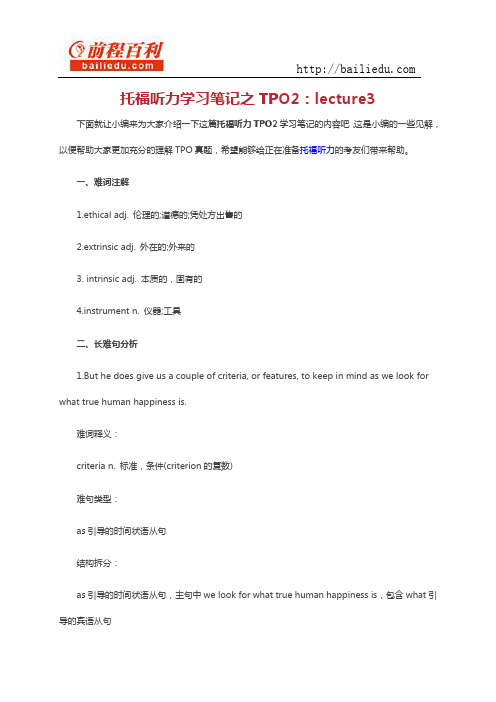
托福听力学习笔记之TPO2:lecture3 下面就让小编来为大家介绍一下这篇托福听力TPO2学习笔记的内容吧,这是小编的一些见解,以便帮助大家更加充分的理解TPO真题,希望能够给正在准备托福听力的考友们带来帮助。
一、难词注解1.ethical adj. 伦理的;道德的;凭处方出售的2.extrinsic adj. 外在的;外来的3. intrinsic adj. 本质的,固有的4.instrument n. 仪器;工具二、长难句分析1.But he does give us a couple of criteria, or features, to keep in mind as we look for what true human happiness is.难词释义:criteria n. 标准,条件(criterion的复数)难句类型:as引导的时间状语从句结构拆分:as引导的时间状语从句,主句中we look for what true human happiness is,包含what引导的宾语从句三、考题对应考点6. we need to discuss is Aristotle—Aristotle’s ethical theory. What Aristotle’s ethical theory is all about is this: he’s trying to show you how to be happy。
开头原则中的直奔主题式,直接指出要讨论的内容,所以答案选D.7.. About Exercise: So I desire to engage in exercise and I value exercise extrinsically . . . not for its own sake, but as a means to something beyond it.About Teaching: but I could make more money doing other things. I’d do it even if they didn’t pay me. I just enjoy teaching. In that sense it’s an end to itself.Health: It’s pleasant to be healthy, unpleasant not to be. So to some degree I value health both for itself and as a means to something else: productivity. It’s got extrinsic and intrinsic value for me.Playing instrument: . I’m a musician, not a professional musician; I just play a musical instrument for fun.首先要了解内在和外在的价值区别。
超详细完整版托福写作笔记,提升托福写作成绩

超详细完整版托福写作笔记,提升托福写作成绩很多考托党为了快速提升托福写作成绩,买了一堆一堆的书,做了一本一本的笔记.......当你累的不堪重负,冲出书海的时候,成绩却还是不尽人意。
为什么?因为你没有一份真正完整!真正干货的托福写作笔记 !今天就把这份压箱底的货都拿出来了,还不滚粗来店铺!托福写作笔记:托福写作概述托福考试写作分为两个部分:综合写作和独立写作1.The Integrated Writing Task:Reading, Listeningand Writing(150-225 words, 20 minutes)2.The Independent writing Task:(300 words, 30 minutes)托福写作笔记:英汉两种语言的区别1、美国人与中国人思维方式的不同。
2、英汉句子结构的特点。
英语重形和,重结构,汉语重意和, 重语义。
英语中常用复合句;汉语则常用短句,简单句。
3、英语多变化,汉语多重复。
4、英语被动句多。
汉语中主动句多。
托福写作笔记:中国学生写作最易犯的十大错误1. Nowadays, collegestudent should learn competition and cooperation.2. The problem that is created bycomputers attract(draw, spark, captivate, intrigue, arouse, yield, give riseto) much attention.3. In present-day society, there are agreat many young people go abroad.4. In my opinion, I think that smokingshould be banned in public places.5. The computer can not instead thepivotal role played byteachers in education.6. Some people welcome raising pets,others hold different opinions.7. In large cities ofChinahas manyfast food shops.8. At college, we should learn as muchknowledge as possible so that we can be well prepared for our future career.9. Some students are interested inplay computer games.10. You really have two down sons.托福写作笔记:托福写作25分必备的50个意群词汇1、持某观点:claim ( contend reckon share the belief that )2、支持某观点:advocate (maintain vote for side with be in favor of )3、反对某观点:contradict (criticize be against cast doubts on )4、合理的:justified ( sensible feasible convincing hold water bear much analysis)5、好处:advantage (benefit, merit, positive side)6、弊端:disadvantage( defect, demerit, negative side)7、肯定:undoubtedly (indeed undeniably there is no denying that)8、不确定:be likely to ( potentially presumably)9、重要的:essential (significant, vital, crucial, critical, fundamental, indispensable)10、有益的:beneficial (conducive instrumental )11、有害的:detrimental (harmful virulent)12、有争议的:controversial (disputable, contentious)13、普遍的:widespread ( prevalent, universal)14、显著地:considerably (significantly, remarkably, dramatically, tremendously, substantially)15、明显的:evident (apparent, manifest)16、增强:enhance (strengthen intensify)17、减少:decline (descend, collapse, relieve)18、大约:approximately(nearly, around, estimated, roughly)19、趋势:trend(tendency, inclination)20、预见:predict (expect, project)21、带来:bring about (result in, lead to)22、引起:create (spark ; yield;; give rise to)23、建立:establish (found, institute)24、要求:call for (request,demand)25、去除:eliminate(remove, eradicate)26、探讨:explore (examine, identify)27、描绘:depict (portray, illustrate)28、后果:consequence( aftermath; outcome)29、足够:adequate (enough; sufficient)30、解决:tackle ( resolve, address)31、意识:awareness(consciousness)32、控制:curb ( regulate, censor)33、解释:account for ( be responsible for)34、投资:finance (invest in, subsidize)35、缓解:relieve ( ease, alleviate)36、压力:stress ( pressure, strain)37、和谐:harmony ( concordance)38、继承:inherit (hand down)39、培养:cultivate (train, foster)40、促进:promote ( contribute to, upgrade)41、适应:adapt to (adjust to, acclimate to)42、提供:provide (render, afford)43、替代:replace (substitute, take the place of)44、保护:preserve (protect)45、证据:evidence (proof)46、赢得:gain (acquire, attain)47、国外的:foreign( alien, exotic)48、灾难:disaster (misfortune, catastrophe)49、发展:advance (progress)50、倾向于:tend to ( be inclined to , be apt to)托福写作笔记:实用加分句子托福写作常用“十大句式”一、否定句1、Instead of indulging in playing computer games, children should betaught how to benefit from useful information on the internet.应该教孩子们如何从互联网获取有益的信息,而不是沉溺于玩电脑游戏。
托福 听力和作文的新东方笔记
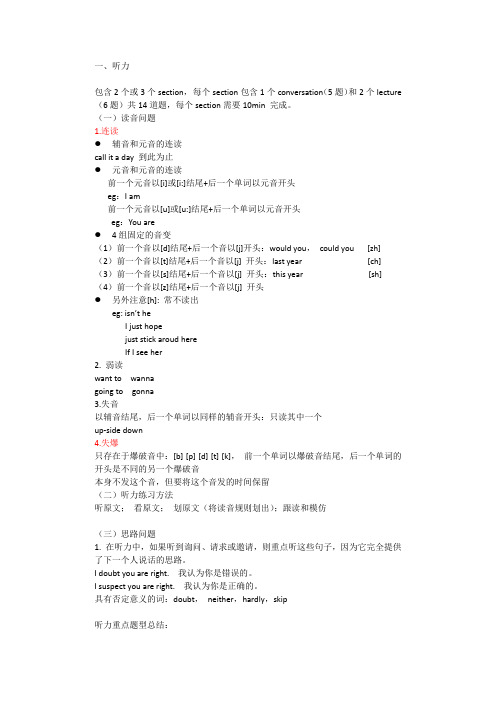
一、听力包含2个或3个section,每个section包含1个conversation(5题)和2个lecture (6题)共14道题,每个section需要10min 完成。
(一)读音问题1.连读●辅音和元音的连读call it a day 到此为止●元音和元音的连读前一个元音以[i]或[i:]结尾+后一个单词以元音开头eg:I am前一个元音以[u]或[u:]结尾+后一个单词以元音开头eg:You are●4组固定的音变(1)前一个音以[d]结尾+后一个音以[j]开头:would you,could you [zh] (2)前一个音以[t]结尾+后一个音以[j] 开头:last year [ch] (3)前一个音以[s]结尾+后一个音以[j] 开头:this year [sh] (4)前一个音以[z]结尾+后一个音以[j] 开头●另外注意[h]: 常不读出eg: isn’t heI just hopejust stick aroud hereIf I see her2. 弱读want to wannagoing to gonna3.失音以辅音结尾,后一个单词以同样的辅音开头:只读其中一个up-side down4.失爆只存在于爆破音中:[b] [p] [d] [t] [k],前一个单词以爆破音结尾,后一个单词的开头是不同的另一个爆破音本身不发这个音,但要将这个音发的时间保留(二)听力练习方法听原文;看原文;划原文(将读音规则划出);跟读和模仿(三)思路问题1. 在听力中,如果听到询问、请求或邀请,则重点听这些句子,因为它完全提供了下一个人说话的思路。
I doubt you are right. 我认为你是错误的。
I suspect you are right. 我认为你是正确的。
具有否定意义的词:doubt,neither,hardly,skip听力重点题型总结:语气题:语气变化的地方,停顿之后是考点,转折题:“but”转折之后几乎是考点建议性的内容:let’s 表示建议,建议的地方几乎都成为考点if 表示条件概念just 表示建议maybe 表示建议,也表达了不确定性remember 表示强调本身就强调的东西:what is important ...强调的句型:I do like it. It is/was ...that ...表示询问、邀请、请求的地方:不仅要听出问题,还要听出下一个人的回答表示最高级的内容表示个人的观点、意见、想法每段对话的开头:经常考到的第一道题就是主旨题,通常在两个人对话开头就提到了。
新东方TOEFL复习笔记(第二部分:语法笔记)2

新东方TOEFL复习笔记(第二部分:语法笔记)2在TOEFL中:____n.(pl.)+v.(sing),一般空格内优先选doing (讲义 31)n)make结构:(讲义31 32)make+obj+宾补obj:n/代词宾补:n./adj.1) make+n1+n2 make the boy president (班长)2) make+n./代词+a. (新题 P78 11)make it unique it:真宾语3)make it possible to do it:形式宾语(讲义 33)that +句子4)make sth possible sht:短宾语 possible宾补make possible sth sth长宾语 possible宾补(新题32)o)the more…the more结构标准句式:the more sub+v1 the more sub+v2!)对称性:结构中的n.前必须有限定词the more the +n1 the more the +n22)省略性:结构中相同的谓语可省,尤其是be动词可省3)倒装性:The more svo , the more svo .是一个复合句。
条件状从主句因此从句不能倒装,而主句(第二个the more)可倒装。
p)表结果的伴随状语从句结构:(讲义 36 37)svo,doing….伴随状语表结果:thus / thereby → svo,thus / thereby +doing…*thus / thereby 后不一定加doing*as f ar / long / early as 出现即为答案/many / muchq)adj短语做后置定语结构:(讲义 38 39)*==等价于定从的省略a door (close to the window) 省略which bea distance (equal to twice)n1+(a.+prep+n2) adj短语foods (high in fat) √leaves (rich in suger) √n1+which be(比较级+than+n2)相当于从句的省略a temperature (highter than 50C)r)adj最高级的省略结构:(讲义 40 41)the most improtant of all booksthe most elaborate of all birdneststhe+a.最高级+单数n. X +of 复数n. 一样错*单数n.必须省略,则the+a.最高级+of+n.(pl.)n.(可代替)→ ad. X / v.过去时Xa. n.(sing) of √ *the a.原级 of+ the restfulof Xthe poor of √s)不规则动词的过去式作谓语结构:(讲义 42 43)She set set-set-setIt cost cost-cost-costIt spread spread-spread-spreadt)规则动词的过去分词作后置定语结构(讲义 44-46)46条:Automatons programmed… 非谓语,整个句子少谓语lack a. be lack ofvi. be lack invt. Sub+lack+obj*如何判断n+v-ed是谓语还是非谓语?eg:n+called call-called-calledWe called him Bush. 主动,过去式,谓语He was called Bush. 被动,过去分词,谓语…a boy called Bush? 被动,过去分词,后置定语根据主/被动确定,主动语态为过去式,被动语态为过去分词,被动式中有be即是非谓语。
托福PPTest2语法题笔记篇(一)

PP Test 2 语法题笔记 Test 2 1~401. Sand is formed by the weathering and decomposition of all types of rock, _________ most abundant mineral constituent being quartz.A. and itsB. since itsC. itsD. it is答案:C分析及考点:独⽴主格结构。
后⾯句⼦没有谓语,所以不⽤连词,A,B错,D形成句⼦跟主句间⼜没有连词,且与being冲突。
参考译⽂:沙⼦是由各种各样的⽯头风化和分解⽽形成的,它含量最多的矿物质是⽯英。
2. _________ in the daytime for most of the year, the groundhog hibernates in a burrow during winter.A. Is activeB. That it is activeC. ActiveD. While is active答案:C分析及考点:考状语的省略结构。
全句的主语是groundhog,谓语hibernates。
A谓语不能单独存在。
B that it is错误结构。
D 缺从句主语。
参考译⽂:⼟拨⿏⼀年中很多时候在⽩天都很活跃,到了冬天就在地洞中冬眠了。
3. The wood of elm trees is used in shipbuilding and in _________ barrels, furniture, flooring, and sporting goods.A. to makeB. as madeC. makingD. to have made答案:C分析及考点:and连接两个对称的结构,且介词后⾯应该跟动名词。
参考译⽂:榆树的⽊头⽤于造船和桶、家具、地板和运动器材的制作。
4. In 1867 Russia sold Alaska to the United States, and in 1958 _________ the forty-ninth state.A. Alaska’s becomingB. Alaska becameC. when Alaska becameD. Alaska to become答案:B分析及考点:and连接对称结构前后都是完整句⼦。
新东方TOEFL复习笔记(第二部分:语法笔记)3(3)

新东方TOEFL复习笔记(第二部分:语法笔记)3(3)3.常考的不规则单复数:(讲义P10 3 4)*tooth划线,这个答案一定错。
foot-foot 单复数一样:步兵horse-horse:单复数一样:骑兵4.常考的单复数同形的名词:(讲义P11 4):*a mean这答案一定错。
5.单复数名词意义有差异:mean:中庸,均值-means:方法,手段,财富water:水-waters:水域(water加s一定不错)part:部分-parts:部分,才能other part:其他部分,以免歧义。
good:好-goods:货物force:;力,力量-forces:武装部队custom:风俗习惯-customs风俗习惯,海关spectacle:光景-spectacles:眼镜arm:手臂-arms:武器6.既可数又不可数的名词:(讲义P21 91.1.21.n.c.&u.)rock:大块岩石,可数;小的岩石,不可数suger:方糖,可数;沙糖,不可数area:面积,不可数;地区、区域,可数collection:由同种物品构成,不可数;由不同种物品构成,可数eg: his art collection /Λ / his three collections of shortstories /c/time:时间,不可数;此数、倍数,可数*当不可数表示种类的时候,就是可数的。
可数/不可数的区别:有无可数的概念,抽象(不可数)还是具体(可数)advertising /Λ /advertisement /c/the meaning of life /Λ?/ 生命的意义their lives /c/ 他们的生命二、冠词(讲义P1 12-23)A、不定冠词(a与an划线80%错)1. a与an的混用:(讲义12)发音而非字母a university a unit a unique an undergradute an understanding an atom an emotion an electrical lamp an hour an honest boy an herba yawn2. a与pl.n.的连用出题方式:a/an+adj+pl.nan outstanding boys X an outstanding boy √【。
- 1、下载文档前请自行甄别文档内容的完整性,平台不提供额外的编辑、内容补充、找答案等附加服务。
- 2、"仅部分预览"的文档,不可在线预览部分如存在完整性等问题,可反馈申请退款(可完整预览的文档不适用该条件!)。
- 3、如文档侵犯您的权益,请联系客服反馈,我们会尽快为您处理(人工客服工作时间:9:00-18:30)。
托福基础班第二次课堂笔记连读类型:1.辅音+元音an apple= a napplean emperor=a nemperoran hour=a nhouran old man=a nold man2.r/re+元音I looked for it here and there. There is a football under it. There are some books on the desk.Here are four eggs.3.辅音+半元音/w/,/ j /Nice to meet you.Would you like a cup of tea? Could you help me, please?摩擦音重合She is a nice sister.That is my brief view.Literature Review 文献综述Interprete v.口译,理解,解释Abstract n.摘要Just in case 以防万一Intend v.意图,打算That’s the idea.=You can say that again.说的没错。
Hurricane n.飓风hit /h/Injure v.受伤Thrill v.颤抖Be thrilled with 对…激动Heritage n.继承,传统Overwhelm v.压倒=swamp v.淹没TPO1 Conversation 11. Why does the student go to see the librarian?●To sign up for a seminar on usingelectronic sources for research●To report that a journal is missing fromthe reference area●To find out the procedure for checking outjournal articles●To ask about how to look for resources fora class paper2.What does the librarian say about the availability of journals and articles in the library?●They are not easy to find if a professor putthem on reserve●Most of them are accessible in anelectronic format●Most of them can be checked out for threeweeks●Printed versions from the past three yearsare located in the reference section.3.What does the librarian suggest the student should do to save time?●Choose an easier research topic●Concentrate on five journals●Read the summaries of the articles first●Install a new program on her homecomputer4.What can be inferred about why the woman decides to use the computer in the library?●She thinks she might need additional helpfrom the man●She does not have a computer at home●She has to hand in her assignment by theend of the day●She will be meeting a friend in the librarylater on5.Why does the woman say this()●She had forgotten about the information●She is surprised she was not aware of theinformation●She is annoyed that the information waspublished only recently●She is concerned that the librarian gaveher incorrect informationTPO7 Conversation 21.Why does the student come to the library?●To learn about the library's resources●To ask about interlibrary loans●To attend the new student orientation●To start work on a research project2.why does the librarian point out the history section to the student?●She wants to point out the closest area containing copy machines●She assumes that he will need to do research there●The student is looking for a book he used at his last school●Students sometimes mistakenly assume that the section contains literature books3.what does the student imply about the interlibrary loan service at his last school?●He never used it●He came to appreciate it●It was inconvenient●It was expensive4.what does the student need to do before he can use any rare books?Click on 2 answers●Purchase a card●Obtain permission●Put on gloves●Try interlibrary loan first5.which sentence best expresses what the librarian means when she says this()●I wish this were true●That is not a very good idea●Thanks for your suggestion●That is what we intendedTPO9 Conversation 2Part 11.What are the speakers mainly discussing?✧A book that the man is trying to find in thelibrary✧A book that the man already returned to thelibrary✧A book that the man is using to write hissenior thesis✧A book that the man lent to his sociologyprofessor2.What does the woman offer to do for the man?✧Let the man know when a book he needs isreturned to the library✧Photocopy a chapter of a book for him✧Ask a professor to return a book the manneeds✧Find a copy of a book for him at anotherlibrary3.What is the woman trying to explain when shementions students who have lost their borrowing privileges?✧Why the man should not photocopy part ofthe book✧The reasons for one of the library’s policies✧What will happen if the man does not returnthe book✧The reason the man has to fill out a form4.How does the man probably feel at the end of the conversation?✧Annoyed that he has to pay a fine on the book✧Upset that he will lose his library privileges✧Glad that he can keep the book for two moreweeks✧Appreciative that the woman is helping him5.Listen again to part of the conversation. Then answer the question.Why does the woman say th is: …✧To make sure she understands what theman’s problem is✧To encourage the man to return the book tothe library soon✧To check whether the man has alreadyreturned the book✧To explain to the man a change in thelibrary’s policiesTPO 18 Conversation 11. Why does the student go to the university office?To apply for a work-study jobTo get information about hosting an exchange studentTo find out if there are any jobs available on campusTo find out eh hours of the computer lab2. Why did the student transfer to Central University?To take advantage of an academic programTo participate in a student exchange programTo attend a smaller university than the one he was at beforeTo benefit from Central University's internationalreputation3. Why does the student mention hosting foreign-exchange students?To explain his interest in a particular field of studyTo explain why he is looking for a job so late in the semesterTo explain why he would like to be an exchange student the following yearTo explain how he learned his computer skills4. What can be inferred about students who apply for the open position at the technology-support helpdesk.They must be enrolled in a computer course.They will only be able to work on weekends.They are willing to work many hours each day they workThey are willing to work irregular hours.5. Why does the woman say this?To dissuade the student from starting a job right wayTo suggest looking for an off-campus jobTo imply that the student might not like the job that is availableTo encourage the student to apply to a work-studyprogramTPO 17 Conversation 21.Why does the man go to see the woman?A.To complain about customers.B.To request an increase in his pay.C.To ask for a change in his work schedule.D.To apply for a job playing music in the dining hall.2.What activity does the man want to be able to do at dinnertime?A.Prepare for his morning music classes.B.Rehearse with a school music group.C.Play jazz for the faculty in the dining hall.D.Eat with classmates from his music class.3.The woman asks the man to consider a different job. What kind of work would the man have to do for the new job?A.Get ingredients ready for a meal.B.Clean kitchen equipment for the cooks.C.Prepare the weekly menu for the dining hall.D.Coordinate schedules for student workers.4.What does the man imply about his job as a waiter?A.It allows him to get to know the professor better.B.It is his first job at the university.C.It does not pay as much as other jobs.D.It interferes with his studies.5.What does the woman imply when she says this?A.She thinks the man should keep his job as a waiter.B.She is grateful that the man is willing to work longer hours.C.The man will have to make many sacrifices to achieve his goals.D.The man does not appreciate the opportunity she is offering him.TPO15 Conversation 11. Why does the student go to the campus newspaperoffice?To turn in outlines of possible articlesTo find out when his article will be printed in thenewspaperTo find out if he got a position as a reporterTo get help with an assignment for his journalism course 2. Why does the student want to write for the campusnewspaper?He wants to earn some money.He wants to learn about the newspaper business.He wants to share his enthusiasm for physics.He thinks the experience will be valuable.3. The student mentions the proposed tuition increase asa possible topic for the newspaper. What does theadviser imply about the topic?The news editor thinks that the topic is not suitable for a new reporter.The news editor was impressed be the student’s outline about the topic.There is not enough information to write an article about the topic.The topic has already been assigned to another reporter.4. What will the student write about in his first article forthe newspaper?The physics department’s plans for attracting morestudents.The university’s plan to offer more physics course.The importance of physics in our daily lives.The opinions of professors on the recent changes tointroductory physics courses.5. What does the adviser imply when she says thisShe is not responsible for evaluating proposed articles.She did not tell Max about the student’s interest in joining the staff.Max recently became the editor of the newspaper.Max has been very busy lately.TPO5 Conversation 1Conversation1Q1: What do the speakers mainly discuss?A.Why the woman has little in common with her roommatesB.How the woman can keep up in her academic studiesC.The woman’s adjustment to life at the universityD.The woman’s decision to transfer to another universityQ2: Why does the woman mention her hometown?A.To draw a contrast to her current situationB.To acknowledge that she is accustomed to living in big citiesC.To indicate that she has known some people on campus for a long timeD.To emphasize her previous success in academic studiesQ3: What does the woman imply about incident that occurred in her sociology class?A.She was embarrassed because she gave an incorrect answerB.She was upset because the professor seemed to ignore herC.She was confused by the organization of the professor’ s lectureD.She was surprised by the comments of the other studentsQ4: According to the counselor, why shouldthe woman visit her pro fessor’s office?Click on 2 answers.A.To offer a complimentB.To offer to help other studentsC.To introduce herselfD.To suggest ways of making the class more personalQ5: What does the woman imply about joining the string quartet?A.It would enable her to continue a hobby she gave up when she was tenB.It would allow her to spend more time in her major area of studyC.It would help her stop worrying about her academic studiesD.It would be a way to meet students with similar interests.。
